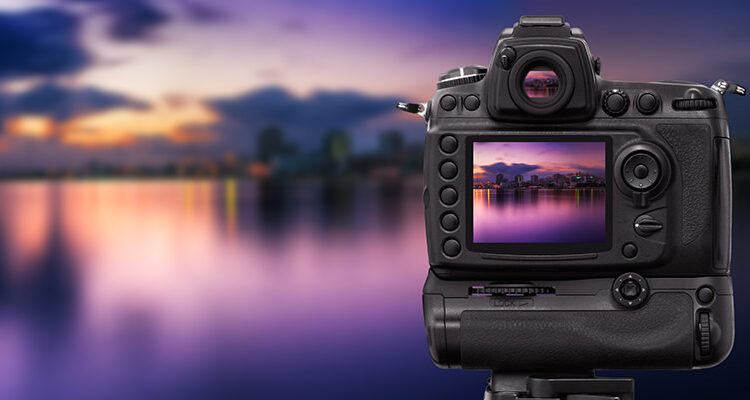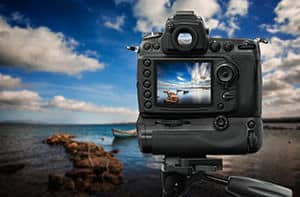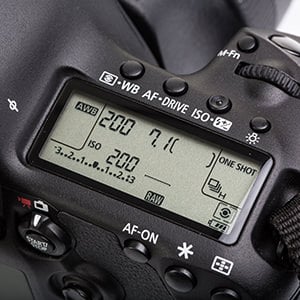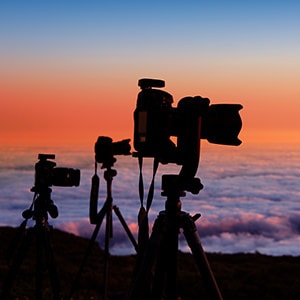
One of the most frequent questions asked by photographers is, what are the best settings for landscape photography for my camera?
There is not necessarily such a thing as ‘the best settings’, but there are settings that many professional photographers use for their work.
Landscape photography settings differ from many other forms of photography.
Understanding the relationship between settings and the effect they have on an eventual image is a critical part to achieving success and capturing great images.
We list these below, or if you would prefer to watch our video on these settings, please click below:
Settings effectively form a bridge between the landscape you are shooting as an input, to your camera and the image you want to eventually output after processing. Here are some of the settings that landscape photographers need to master:
1. Using RAW instead of JPEG files
When out capturing landscape photography images changing your file setting determines the quality of what we’re going to use, whether it’s JPEG or RAW.
Using JPEG files is like driving a Ferrari in first gear. You’re not getting the most out of that file.
So that’s why we always recommend to shoot RAW, which captures the most information, and you can do so much more with those files.
This should be the first thing you change when trying to get the best settings for landscape photography.
Just shoot RAW, keep it simple, and then you’ve got that file. Maybe if you want to send things out over social media, you might shoot JPEGs, but it’s quicker just to shoot RAW. Stick with RAW!
2. Metering for the right exposure
Modern digital cameras usually offer a choice of settings on how they read and evaluate light, known as meter settings.
We get a lot of questions asked about what sort of metering modes should be used?
Many professional photographers primarily use matrix metering or evaluative metering.
Matrix/Evaluative Metering
This type of metering system usually works best for landscape photography as your camera is taking readings using a mix of colours and tones from your selected composition.
Mainly that’s because it’s taking four corners and the center and averaging all of those points out in the frame, so it’s taking an average over the whole frame.
Spot Metering
Spot metering can be useful for certain occasions.
In complete contrast, spot metering uses a system of analysing a very select area of a frame.
This can therefore be very useful if your subject matter is significantly lighter or darker than the rest of the frame, so you can correctly expose the image.
Situations where this can be useful include small backlight subjects where you may want to avoid a silhouette effect.
Ensure detail is captured on your principal subject area (normally just around your centre of focus point).
But with cameras nowadays, why create more work than what you need? So use the matrix metering, make life simple for you.
3. White Balance settings
Using digital cameras means photographers need to be aware of landscape photography settings for correct white balance.
These important settings affect how your camera reads the colours it is capturing a digital image of.
The range of colours captured is known as color temperature and is measured in Kelvin (K) with values ranging from 1000K to 15,000K.
As a general guide, a light source emitting a higher color temperature will generally be emitting more blue light (higher Kelvin value) and lower light produces a lower Kelvin value.
Whilst human eyes automatically adjust to different values to produce a true color digital images have to be told what color temperature is being captured.
Most cameras will have an Auto White Balance setting (AWB) and depending on manufacturer, on many occasions these can prove reliable for general day to day use.
However, many landscape photographers prefer to control this process and either switch their white balance to pre-set camera settings for different conditions or manually set their White Balance.
For more information on how to do this, see our dedicated blog on this subject.
For landscape photography, most professionals generally use daylight white balance.
This is mainly because they like to see the difference where you’ve got the cool colors of the ambient light with the warm sky for example.
So if you’re using, say, auto white balance for a sunrise or sunset, it’s going to wipe out all that brilliant color, so stick to daylight.
Now, there are times when auto white balance is actually better.
For example, if you’re using mixed light sources, you’re photographing an interior or towns where you have a lot of mixed lighting, then auto white balance is great.
It takes out that color cast and balances the daylight with the incandescent lighting or sodium vapor lighting.
Now, there are other white balance settings, such as tungsten, incandescent, cloudy white balance.
These are all great, but remember, because you’re shooting in RAW, it doesn’t make any difference.
It’s only going to make a difference to the JPEG setting on your display of how it’s going to appear.
When you get that image back into your computer, you can adjust those settings how you like.
4. Camera Mode settings
So next on our list is which camera setting mode should I use?
Our advice is to like to keep things simple. Why make things more difficult than you need to be?
A lot of photographers love using the Manual setting and might argue this is one of the best settings for landscape photography.
Manual does have its place at certain circumstances, but you have to think about two things, your aperture and your shutter.
Now in Aperture Priority, you’re thinking about one thing. In landscape photography, it’s the aperture.
What aperture are you going to use for any particular instance?
So say if you’re shooting something really quick, you’ve got lighting that is happening, you’ve got to act fast, just think about the aperture, let the shutter go.
Because you’re on a tripod, it doesn’t matter what shutter speed you’re shooting at, unless you’re trying to get a certain effect, like a long exposure or something like that.
So Aperture Priority for many professional landscape photographers is considered the best camera mode setting, and then you can always adjust the exposure compensation dial accordingly, if needed.
5. Setting focus points on a camera
A lot of cameras have 51, 90, 100 focus points or more.
Many professionals tend to use one, because they like to know exactly where they are putting their focus point on a scene.
Using manual focus is also quite common, because some photographers don’t really like to trust the autofocus too much.
If you can’t find a really nice contrast bit for it to bite onto, the focus might go in and out slightly.
But if you’re focus in live view manually, you can see that it’s actually pin-sharp and it’s not going to drift at all.
So the focus point, we would recommend is to use one focus point.
6. ISO settings
To correctly expose an image awareness is needed between the interrelationship between light sensitivity (ISO), shutter speed and aperture.
ISO is acronym for International Organisation for Standardisation, but for photographers it basically means a numerical value which defines the sensitivity of a sensor (previously film) to light levels.
 ISO values normally span from 100 to 6400 – the lower being the lowest sensitive to light; with the highest being more sensitive to light.
ISO values normally span from 100 to 6400 – the lower being the lowest sensitive to light; with the highest being more sensitive to light.
Being able to use different ISO settings allows photographers to overcome the challenge of shooting images in different light levels.
Higher levels of ISO have historically degraded the quality of an image and typically the higher the value the more the corresponding level of digital noise on an image.
Modern cameras and post processing software help to partially overcome such issues albeit the basic rule remains.
Landscape photographers will normally want to capture the highest quality image possible, which means using the lowest possible ISO setting that is appropriate for the lighting conditions.
In lower light conditions like sunrise and sunset, shutter speeds quickly fall which means there is a risk of camera shake.
This is one of the reasons landscape photographers typically use a tripod when taking shots, to try to eliminate the risk of any blur and loss of focus.
Which ISO setting do you use for landscape photography?
Firstly, take your camera off auto ISO.
Don’t use that unless you’re using video, of course. But we’re talking about landscape photography, so set it to generally a100 ISO, which will serve most cases.
Sometimes it may be necessary to knock it down to 50 or the lowest setting just to gain a little bit more exposure time.
But in general terms, 100 ISO is going to be the best for landscape photography.
7. Use Live View on your camera
We mentioned live view earlier in this article, so let’s discuss how you can use it.
As mentioned, many photographers use live view for focusing.
For manual focusing, it’s great.
You can zoom into a hundred percent and see exactly, especially using one of these.
Switch that on, you can see your scene. Zoom right in and then focus sharp detail with this.
You can block out all the sun and you can see exactly what you’re doing with this.
So live view is a wonderful feature.
Also with live view, you have the opportunity to use histogram on it as well, so you can see at a glance how your scene is performing as far as how much information you have and if you’re clipping any shadows or highlights or whatever.
8. Use your histogram
We mentioned above using the histogram on your camera.
The histogram is great for judging how much information you’re capturing.
So a lot of people tend to shoot for the display and see, “Oh, that’s a lovely picture,” but it’s not actually giving you the amount of information that you really could get.
So always shoot for your histogram and not for your display.
9. Always use a cable release or self-timer for landscape photography
Next on the list is a self-timer.
Technically, it could be argued that this does not fall under the best settings for landscape photography, but it is fundamental, hence including this on our list.
Ideally, you want to buy a cable release so you don’t have to touch the camera at all but if you don’t have one of those, you can use the self-timer.
Set it to two seconds or ten seconds, just so that you’re taking your hands off the camera while it takes the picture.
Don’t spend a lot of money on a cable release.
Don’t buy one of those cable releases that have time-lapse feature and all these different features on it, and it takes batteries.
Just buy the very basic cable release with a lock on it, that’s really all you need.
Most cameras now will have features such as time-lapse built into the camera, so you don’t really need it on a cable release where you’re spending a couple of hundred dollars or pounds on. So just keep it simple.
10. Choose the right aperture
Finally, we should discuss aperture settings, albeit this is could be a whole article in itself!
Virtually all digital cameras with interchangeable lenses offer a range of shooting settings.
These come with different available apertures.
 As mentioned earlier, the landscape photography camera settings that you will typically wish to master is Aperture Priority, albeit Shutter Priority can be handy for certain scenes.
As mentioned earlier, the landscape photography camera settings that you will typically wish to master is Aperture Priority, albeit Shutter Priority can be handy for certain scenes.
Both settings do exactly what they say in terms of automatically changing other settings once you have first manually adjusted your aperture or shutter speed to fit the image you are trying to capture.
Prioritising shutter speeds can be useful in low light situations or for capturing fast moving subjects, but in context to landscape photography, aperture priority is one of the most popular and useful settings.
The primary reason for this is that it allows photographers to control depth of field which will affect the final look of an image in terms of focal sharpness and managing the available light.
Aperture settings will vary depending on the lens being used, but typically range from F4 to F22.
There is much debate on the best setting for landscape photographers and whilst F8 aperture setting is widely used for a number of landscape photography images due to its optimal performance, in essence it will always depend on the circumstances of the image being taken and the look that a photographer is trying to achieve.
10 best settings for landscape photography – quick checklist
- Use RAW file setting
- Set camera to Matrix Metering for most landscape scenes
- Daylight white balance works for many scenes in landscape photography – judge your scene though
- Turn camera mode onto Aperture Priority for most landscape scenes
- Use one focus point on camera settings
- Keep ISO setting at 100 for most normal scenes for maximum quality image and less noise
- Do turn on and use Live View on your camera
- Shoot from your histogram not your display
- Use a cable release or self-timer for a steady shake-free exposure
- Select the right aperture setting for your scene
Lastly, don’t forget the relationship between these settings and the impact of changing one setting could trigger the need to change other settings.
We hope this article has been useful, showing you how to use camera settings.
Everybody has their own different way, but this is how many professional photographers like to use them and we hope this inspires you to get outside, experiment and capture some great images.

